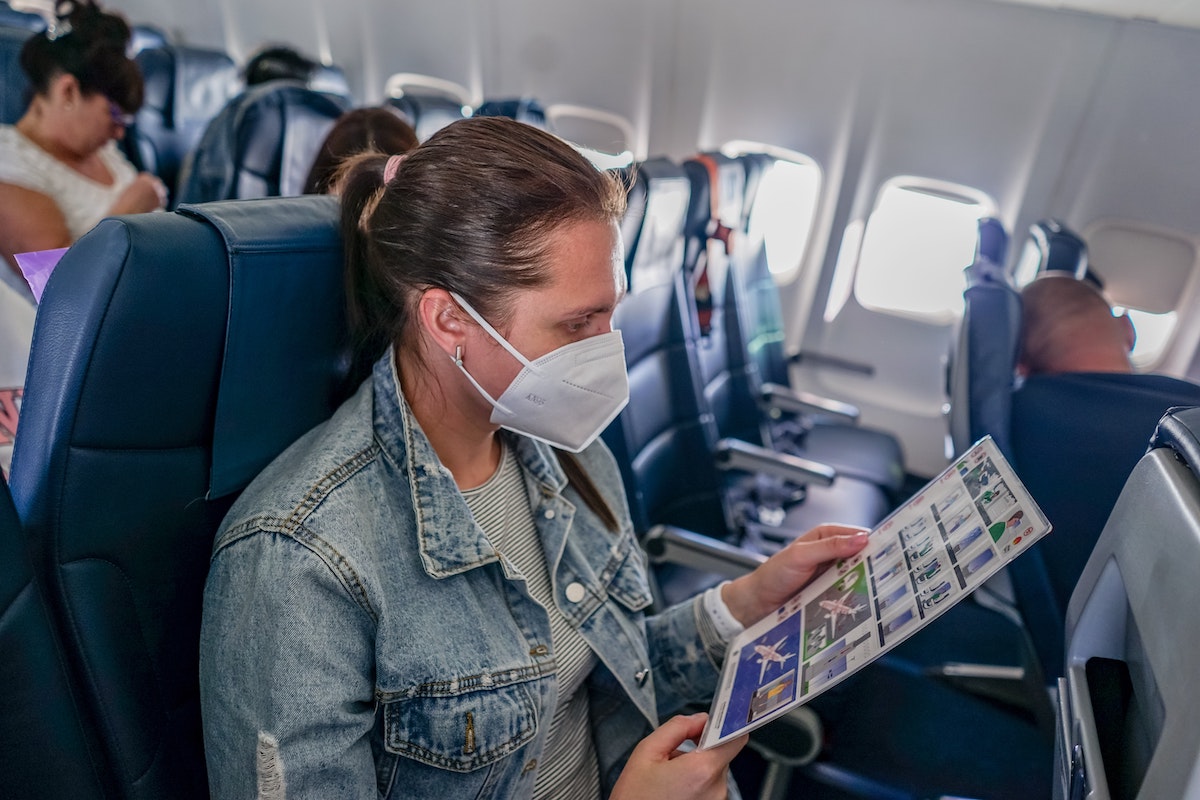
9 Tips for Staying Healthy on a Long-Haul Flight
By: Sarah Stone
Skip to Section
Article Summary
Long-haul flights don’t have to destroy your sleep, your skin, or your sanity—small changes to how you prep, sit, move, and snack can make all the difference.
This guide walks through everything you should do before and during a long flight to feel better when you land. From staying hydrated to preventing blood clots, it covers the stuff you actually need to know—not just the usual “bring snacks” advice.
- Drink water often, avoid caffeine and alcohol, and pack electrolyte drinks if needed.
- Get up regularly, move your legs, and avoid crossing them to keep blood flowing.
- Pack snacks you actually want to eat—and that won’t wreck your stomach halfway through the flight.
- Bring a neck pillow, disinfectant wipes, and noise-canceling headphones to avoid common mid-air discomforts.
- Loose clothes, deep breathing, and the occasional aisle seat can turn a long flight from miserable to manageable.
Dreading that long-haul flight you have coming up? I don’t blame you!
Whether you’re traveling cross-country or even all the way around the world, embarking on lengthy journeys through the skies can take a toll on our physical well-being—but a handful of mindful practices can help make things easier.
Let’s look at a few strategies for surviving a crazy long flight!

Photo by Oleksandr Pidvalnyi on Pexels
1. Drink Lots of Water
Staying hydrated is one of the very best ways to keep healthy on your long flight—it’s just a good habit anyway, but it also can help combat annoyances like headaches, fatigue, and parched skin. The air within aircraft cabins is notoriously dry, exacerbating the risk of dehydration during your flight, so to get ahead of this, make sure to drink lots of water before, during, and after your journey. As a general guideline, aim to drink a minimum of 8 ounces of water per hour while in the air.
As tempting as it may be to ask for coffee or alcohol during your flight, it’s best to steer clear of both of these—their diuretic properties can contribute to dehydration and give you a flight hangover after you land. Instead, opt for beverages like herbal tea or electrolyte-infused drinks.
2. Combat Poor Circulation and Blood Clots
Sitting for extended periods of time can hinder proper circulation and even lead to the formation of blood clots. This is especially important if you tend to cross your legs.
To avert these risks:
- Stand up and stretch your legs every couple of hours
- If doable, take small strolls up and down the aisle to stimulate circulation
- Perform simple seated exercises, such as ankle circles or calf raises, to engage your leg muscles
- Try a footrest or place a carry-on bag under your feet to elevate your legs slightly, which helps to facilitate better circulation
3. Pack Healthy, Wholesome Snacks
Airports and airplanes are notorious for offering limited healthy dining options. To get ahead of this, pack an assortment of healthy snacks for your journey. A few suggestions for health-conscious travelers:
- Fresh fruits: Opt for low-maintenance options like apples, bananas, or oranges that require minimal preparation and are easily portable
- Nuts and seeds: Almonds, walnuts, sunflower seeds, and pumpkin seeds are a great source of healthy fats and proteins
- Protein bars: Look for bars with minimal added sugars and a good balance of protein, fiber, and healthy fats to keep you fuller, longer
- Hummus and veggie sticks: Prepackaged single-serving hummus containers paired with carrot or cucumber sticks make for a great snack
4. Bring Along a Neck Pillow or Cushion
Having adequate support for your head and neck while sleeping will help reduce strain and keep you comfortable. A few tips for choosing the ideal travel pillow:
- Material: Memory foam, microbeads, and inflatable options offer different levels of support and comfort
- Shape: U-shaped, wraparound, and convertible designs cater to different sleeping positions and preferences
- Portability: Collapsible and inflatable models can save space in your carry-on luggage
5. Maintain a Germ-Free Zone
Airplanes are notorious for harboring germs and bacteria, making it super important to sanitize your immediate surroundings for a healthier in-flight experience. Take the time to thoroughly clean your seat area, tray table, and armrests with disinfectant wipes. This simple action can significantly reduce your exposure to illness-causing pathogens.
6. Dress for Comfort
Wearing comfortable, loose-fitting, and breathable clothing during your flight can help prevent the swelling and discomfort that’s often associated with prolonged sitting. And dressing in layers lets you adjust your attire according to fluctuating cabin temperatures—especially if you’re like me and you get super cold when you sleep! Here are some recommendations for travel-friendly attire:
- Tops: Go for soft, moisture-wicking materials like merino wool, which is both breathable and odor-resistant
- Bottoms: Choose loose-fitting pants or leggings that offer unrestricted movement and won’t dig into your skin
- Footwear: Slip-on shoes or sneakers with ample cushioning are ideal for easy removal and accommodating potential in-flight swelling—just make sure you’re cognizant of your fellow passengers if you need to remove your shoes!
- Layers: Pack a lightweight jacket, hoodie, or sweater to adapt to changing cabin temperatures or use as an extra blanket if needed
7. Bring Noise-Reducing Devices
Investing in noise-canceling headphones or using earplugs (or even earbuds to an extent) can be a game-changer if you want to block out ambient noise—and especially if you want to sleep—during your flight. I can’t tell you how much better my life has been now that I’ve got noise-canceling headphones that can filter out babies crying and instead let me pay attention to podcasts or music.
- Noise-canceling headphones: Choose between over-ear or in-ear models, depending on your comfort preference. Some models even offer adaptive noise-cancelling technology that adjusts to your environment.
- Earplugs: Reusable silicone or foam earplugs can be molded to fit your ear for optimal noise reduction
8. Choose an Aisle Seat
I’m a window seat person most of the time, but there’s something to be said for aisle seating, especially if you need to get up and move around or use the facilities. You can also reach your stowed items more easily, which can be super important if you have snacks, entertainment, clothing, or other items you’ll need to retrieve and put away frequently.
9. Practice Deep Breathing and Meditation
Incorporating deep breathing exercises or meditation into your in-flight routine can work wonders in alleviating anxiety—super helpful if you’re a nervous flyer or if this is your first long flight. Consider the following techniques:
- Diaphragmatic breathing: Breathe deeply into your diaphragm, allowing your belly to expand while keeping your chest relatively still. Exhale slowly and fully. Repeat for several minutes to encourage relaxation and reduced stress.
- 4-7-8 breathing: Inhale for four counts, hold the breath for seven counts, and exhale for eight counts. This technique can help slow down your heart rate and create a sense of calm.
- Body scan meditation: Close your eyes and mentally scan your body from head to toe, consciously releasing tension from each muscle group as you progress. This practice can enhance body awareness and facilitate relaxation. I actually use that one to fall asleep more quickly!
Embarking on long-haul flights doesn’t have to be a terrible or uncomfortable experience. Even while traveling through lots of timezones, interrupting your regular schedule for…well, everything—there’s a lot you can do to make your journey much more comfortable so that you’re ready to hit the ground running, wherever you’re going.
Safe travels!
About the Author
 As the editor-in-chief of Frayed Passport, my goal is to help you build a lifestyle that lets you travel the world whenever you want and however long you want, and not worry about where your next paycheck will come from. I've been to 20+ countries and five continents, lived for years as a full-time digital nomad, and have worked completely remotely since 2015. If you would like to share your story with our community, or partner with Frayed Passport, get in touch with me using the form on our About page.
As the editor-in-chief of Frayed Passport, my goal is to help you build a lifestyle that lets you travel the world whenever you want and however long you want, and not worry about where your next paycheck will come from. I've been to 20+ countries and five continents, lived for years as a full-time digital nomad, and have worked completely remotely since 2015. If you would like to share your story with our community, or partner with Frayed Passport, get in touch with me using the form on our About page.Featured image by Suhyeon Choi on Unsplash
Information published on this website and across our networks can change over time. Stories and recommendations reflect the subjective opinions of our writers. You should consult multiple sources to ensure you have the most current, safe, and correct details for your own research and plans.
Frayed Passport is a participant in the Amazon Associates Program, an affiliate advertising program designed to provide a means for sites to earn advertising fees by advertising and linking to Amazon.com. We also may share links to other affiliates and sponsors in articles across our website.




